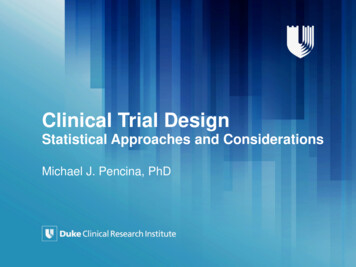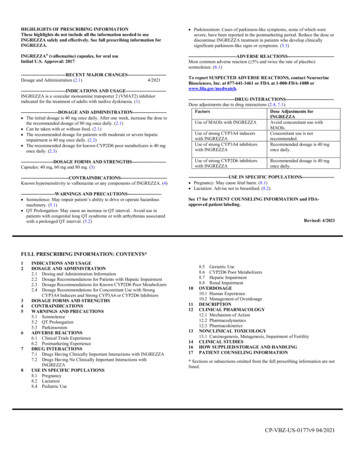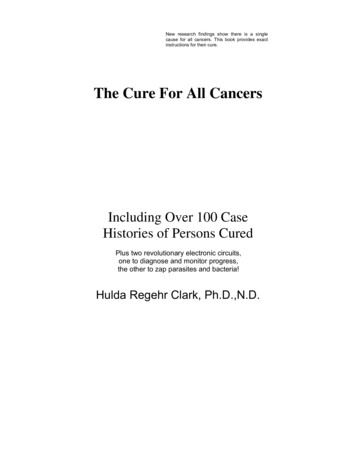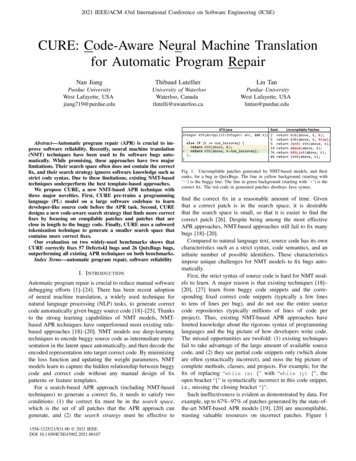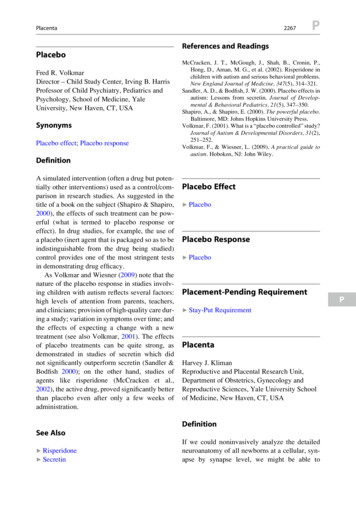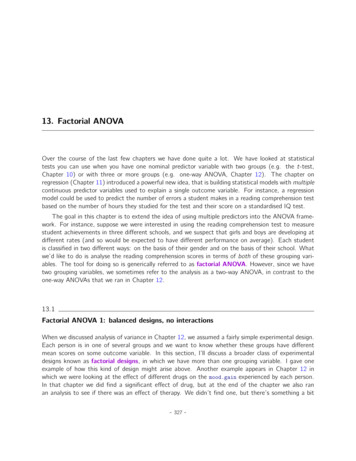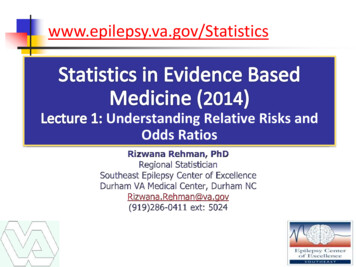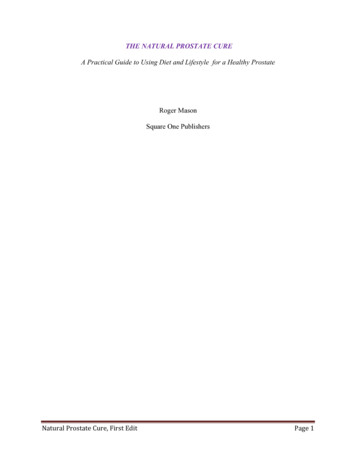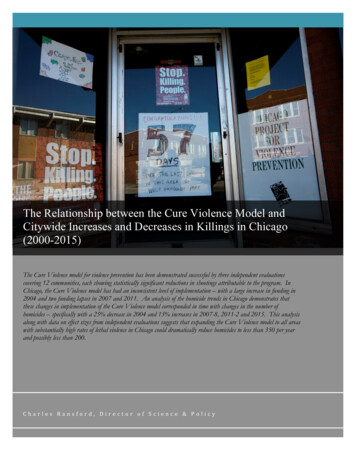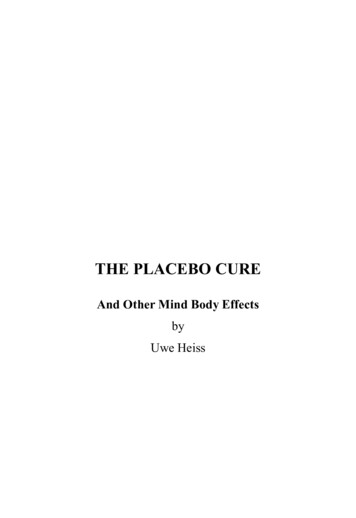
Transcription
THE PLACEBO CUREAnd Other Mind Body EffectsbyUwe Heiss
Heiss / Placebo Cure / 2ContentsThe Placebo Cure . 1This Book . 3Habits Guru . 7The Gummy Bear Effect. 9Chapter I . 12Placebo Terminology . 12Chapter II . 42Placebos Work . 42Chapter III . 66Placebo Value. 66Chapter IV . 95How Placebos Work . 95Chapter V. 127Placebo Manual for Patients . 127Chapter VI . 139Placebo Manual for Care Providers . 139Chapter VII . 172Beyond Placebo . 172Chapter VIII . 191A Five-step Plan for Everything . 191Full Disclaimer . 192References . 197Index . 215
Heiss / Placebo Cure / 3This BookThis book is for anyone who seeks well-being andis open to exploring the power of their mind andbody to relief symptoms self-heal enhance performance grow as a human beingThis book is a life hack. We will cover the coreexperience of modern health care: taking pills. Thepurest version of this experience is to use pillsdesigned to convey meaning, set expectations, andtrigger healing in the absence of active ingredients in other words, pure placebo. We'll rethink whatplacebos are and how to design placebo-takingexperiences that are honest, safe, and beneficial.I'll propose to use well-designed, branded placebosthat are free of any active ingredients and are takenin a state of full awareness. These are 3rd Generationplacebos. Honest placebo-rituals offer patients new
Heiss / Placebo Cure / 4ways to complement traditional medicine. I expectthat 3rd Generation placebo-experiences will provideimmediate benefit to many people. However, priorto using placebos, life style changes can help inmany situations. There are highly effective and safeways to obtain health and well-being that oneshould try out before taking placebos. Here are justsome of my favorites: exercising eating mindfully deep mediation staying hydrated getting enough sleep having a fulfilling social and work lifeFor doctors, honest (double unblinded) placeboadministration offers new options to deliver care ina safer, more effective and more structured way.Here is how I let the story unfold in this book:I am start by proposing an update to placeboterminology, followed by a description of keystudies that explored placebo effects. I'll group the
Heiss / Placebo Cure / 5benefits of placebo experiences into four maincategories and summarize for you how placebosmay work. I am concluding the book with shortplacebo manuals: one for patients and one fordoctors. The final chapter describes the multipleways to well-being beyond the placebo experience.The basic principles of this book are honesty andtransparency. My re-design of the pill-taking ritualis based on honesty and trust. Where possible I backup my statements with research and cite sources.Where there is no research available, simply takemy words as hypotheses to be explored further.Enjoy this journey into the re-design of pill-takingexperiences, fascinating studies, and mind-bogglinghacks for complex systems. My wish is that thisbook helps you, that it advances placebo practice,and that it stimulates more research in thisimportant field.Contributions I intend to make with this book:
Heiss / Placebo Cure / 6Proposal for an advanced placebo terminologyOverview of placebo studies and historyFramework for safe and ethical placebo usePlacebo innovationsEffective placebo designIndividual placebo outcomes trackingNew applications for placebosCreate, help others, feel better, get better, be honest,- Uwe HeissDisclaimer: The content of this book is not medicaladvice. I am not a physician, just an interestedindividual sharing my thoughts. Next to this book Icreated the placebo brand 'Zeebo'. We make pure,honest placebo pills. Read the full disclaimer at theend of the book.
Heiss / Placebo Cure / 7Habits GuruFrom here I am taking the placebo-way to make adent in the healthcare universe.- Uwe HeissHow did I get here?I have worked for more than 20 years on patientempowerment and healthcare transformation. Icared for terminally ill patients, helped new drugsreach the market faster, created awareness forneglected medical conditions, built apps thatempower patients with symptom tracking, andintroduced patient-reported outcomes tracking inregular care. On the way I helped start companiesthat catalyze change and I think will have a lastingimpact on healthcare.My goal for the next five years is to bring all thistogether in the form of an integrated solution thatmakes medical care safer and more effective.
Heiss / Placebo Cure / 8My goal: Embed transparent placebo use in regularcare
Heiss / Placebo Cure / 9The Gummy Bear EffectI had my first experience with placebos when I wasvery young. This is one of my very first memories.Whenever I had a minor injury as a child, mymother would place a Haribo Gummy Bear on theboo-boo, the site of pain. She would tell me that“this gummy bear helps against pain” and that I wasallowed to eat the gummy bear when the pain wasgone. She told me that green gummy bears wereespecially powerful. Tears dried on the spot. Iexperienced immediate pain relief. Today I am stillsurprised about how pain can turn into just a fadingmemory, and how attention shifts to some otherattractor. My placebo-experience catalyzed a shiftfrom pain and anxiety to relief and restored wellbeing. It all took place in a caring environment thatmade it absolutely safe to get better. I stillremember and can recall that feeling of absolute
Heiss / Placebo Cure / 10trust. I like this story. It is a warm childhoodmemory. I rely on it often. When I saw the GummyBear Effect later with my own children it becamecurious to find out if such a healing experiencecould be made available to all of us.The Gummy Bear Effect is a story that also raisesquestions that are at the heart of placebo research.Here is one:What promotes self-healing?When we are in a state of sickness, does theexperience of a caring, assuring environment signalour mind and body permission to switch-off stressand to turn-on symptom-relief and self-healing? Isthere an On/Off switch to our immune system?I'll explore these questions, and also offer practicalideas, tools and designs that draw on what we canlearn from family traditions, good patient-doctor
Heiss / Placebo Cure / 11relationships, and clinical studies. I'll describe safeways to create and benefit from placebo effects.As I write this I have people in mind like myselfwho grew up in a caring environment and thentransitioned into a medical world illuminated by thebright light of powerful medical brands.Let's explore how we can use pure placebos toharvest medical brand power in a safe and honestway.
Heiss / Placebo Cure / 12Chapter IPlacebo TerminologyPlacebo Generations 1 – 2 – 3Placebo 1.0The word placebo stems from Latin. It originallymeant “I will please.” An early 19th century medicaldictionary by Quincy defined a placebo as anymedicine that was given “more to please than tobenefit the patient.” Until the 1950s medicalstudents learned that placebos were “mere sugarpills that do nothing”. Placebos did not get muchattention then. I propose to call this era PlaceboGeneration 1.0Placebo 2.0The possibility of a real therapeutic benefit fromplacebo was first investigated by Dr. Henry
Heiss / Placebo Cure / 13Knowles Beecher (1904–1976), an anesthesiologistat the Massachusetts General Hospital. He noticedthat severely injured soldiers in the combat zonewere less likely to ask for pain relievers comparedto similarly injured soldiers who were at hospitals.He theorized that injured soldiers in the field maybe able to bear pain better, because they are relievedor even euphoric to have survived and look forwardto being put back together again. This mindsetmight allow them to tolerate pain better, or mighteven reduce the intensity of pain. Yet, by the timeseverely injured soldiers reach the hospital theireuphoria has worn off and they are likely to feelmore anxious, for example about their financial andsocial future. This led him to study the mind’simpact on pain control and self-healing and. Hewrote a paper in 1955 on “The Powerful Placebo”which was published in the Journal of theAmerican Medical Association (JAMA), claimingthat “placebos have a high degree of therapeuticeffectiveness in treating subjective responses.”
Heiss / Placebo Cure / 14Since then, research on placebos graduallyaccelerated. Especially the discovery of the role ofnatural opioids released by the body was a majorbreak-through in this field. In 1978 a landmarkexperiment showed how pain relief from placeboactually has a physical effect on our body. Levine etal, used naloxone, a drug that blocks the effects ofopiates on patients who had just undergone dentalsurgery. Levine's experiment showed that naloxonenot only prevented pain relief from opioids, but italso blocked pain relief from placebo. This gavestrong support to the hypotheses that takingplacebos can trigger the body to employ its ownnatural opioids (called endorphins).OpioidsOpioids are the most powerful drugs used for painrelief. This class of drugs is widely prescribed buthas resulted in a controversy due to a 4-fold
Heiss / Placebo Cure / 15increase in deaths over the first decade of the newmillennium.NaloxoneWhen the medication Naloxone is given, it blocksthe body's opioid receptors and prevents othersubstances from binding to these receptors.EndorphinsEndorphins are powerful and safe opioids that thebody produces. Endorphins bind to opioid receptorsin the brain. The same receptors are also used byopioid medications.Recent studies using the brain-imaging technologyshowed that taking placebos leads toneurobiological patterns in the brain that can also beobserved when powerful pain relievers are given.Petrovic et al (2002), demonstrated that the sameregions of the brain are activated when patients
Heiss / Placebo Cure / 16receive an opioid pain reliever (remifentanil) orwhen patients take a placebo. Similar brain imagingstudies by Zubieta et al (2005) and Eippert et al(2009) also showed that placebos trigger brainresponses that ameliorate pain.For those who are interested in learning more aboutfascinating field of brain imaging in Neuroscience,the studies described here used two techniques togenerate high definition, three dimensional imagesof brain function:Positron Emission Tomography (PET)PET measures metabolism and the flow of blood todifferent parts of the brain. PET is a non-invasivemethod that also allows for some movement duringthe scan, but it does expose patients to radiationfrom a biologically active tracer molecule.Functional Magnetic Resonance Imaging (FMRI)
Heiss / Placebo Cure / 17Similar to PET scans, FMRI measures blood-flowin the brain. FMRI has the advantage that aradioactive tracer molecule it not needed. Theimage resolution of FMRI is also better than PET.However, since patients need to remain still duringFMRI scans, this imaging method cannot be usedfor experiments where, e.g., patients need to readout words during a scan. Redesigned equipment andadvancements in computing power are likely toovercome this barrier in the future.In the 1980’s The US Food and DrugAdministration (FDA) started to require the use ofplacebos to demonstrate the therapeuticeffectiveness of new drugs before giving marketapproval. The basic concept of FDA effectivenesstrials is to compare a new drug to be tested to aplacebo pill that looks exactly alike but is assumedto do “nothing”. FDA reviewed clinical trials areusually randomized, double blind studies, neitherdoctor nor patient know if the drug or the placebo
Heiss / Placebo Cure / 18are administered. During the initial years ofplacebo-controlled trials there were many surpriseswhen beneficial therapeutic effects were observednot only from the new drug to be approved, but alsofrom its placebo counterpart. Thanks to the rigorousdesign of large clinical trials we now have ampleevidence that placebos are efficacious. Later in the90s the National Institutes of Health (NIH) startedto fund placebo specific research that provided usmore insight into how placebos work.That being said, up to now there are no therapeuticoptions available to use pure placebos outside ofclinical studies. The use of placebo Generation 2.0was neither feasible nor considered to be ethical inthe regular care of patients. The paradigm of thePlacebo 2.0 era states that 'patient deceit is requiredfor placebos to work'.For a paradigm shift to occur it is not enough tosimply falsify its foundational laws. It also takes acontrarian mind to simply acknowledgeobservations that contradict a paradigm. Scientific
Heiss / Placebo Cure / 19paradigm shifts are typically slow and only seenretrospectively. This was first observed by ThomasKuhn and described in his book “The Structure ofScientific Revolutions” (1962). The dynamics ofsuch fundamental shifts is also explored in morerecent books such as “The Tipping Point” (2000) byMalcom Gladwell.For more than twenty years after the therapeuticbenefits of placebos were demonstrated in clinicaltrials not a single study questioned the fundamentalbelief that “placebos can work only with deceit”.Placebo 3.0It took a contrarian thinker to pursue the idea thatthe placebo effect could be reproduced in subjectsthat knew that they were taking placebos (honestPlacebo).The idea that honest placebos” work wasinconceivable for anyone thinking inside theplacebo paradigm of the day. Paradigm shifts
Heiss / Placebo Cure / 20require observations that are either stumbled uponby accident or are gathered purposely by acontrarian thinker. Ted Kaptchuk, Professor atHarvard’s Center for Placebo Studies, is such acontrarian. Utilizing an ingeniously simple studydesign that explored honest placebo use, resulted ina paradigm-shifting landmark study that waspublished in 2008.Two groups of patients with Irritable BowelSyndrom (IBS) received standard treatment. One ofthe groups also received a placebo in addition totheir standard treatment. They were told thatplacebos had shown some beneficial effect inclinical trials. These patients were told that theywould receive pure placebo pills and that was notnecessary to believe in the placebo effect, but anopen mind could be helpful. The pill bottles thatpatients took home were clearly labeled “Placebo”.The outcome? The group that received a placebo inaddition to standard treatment improvedsignificantly more than the group that only received
Heiss / Placebo Cure / 21standard treatment. Taking placebos in an honestway made a meaningful clinical difference for thesepatients.This study really marks the start of the 3rdgeneration of Placebo treatment.ZeeboDisclaimer:To shape the 3rd Placebo Generation, I createdZeebo - pure, open, branded placebo, taken in anhonest way. Zeebo was designed to create acomplete placebo-taking experience. Zeebo pillssupported by the Zeebo App provide a showcase ofhow to deliver a honest placebo effect.This book is a general introduction to 3rd Generationplacebos. Zeebo is only mentioned here and in thechapter on “Placebo Examples”. If you want toknow more about Zeebo, please go to:www.zeeboeffect.com
Heiss / Placebo Cure / 22PlaceboEffectiveHonestGeneration 2‒ ‒‒Generation 3 Generation 1Ancient Healing and PlaceboFor those who are interested here is a little moreabout ancient healing and placebo.Most ancient drugs contained no active ingredientsthat would benefit the patient. There are someexceptions, such as poppy milk given for painmanagement. At the same time ancient drugs oftendid contain active ingredients that could harm thepatient. For example, highly toxic mercury saltswere given for some chronic conditions well intothe 20th century.Given the long history of medicine, science enteredmedicine only recently, about 200 years ago. Using
Heiss / Placebo Cure / 23scientific method we learned to better distinguishbetween active vs. non-active and beneficial vs.harmful ingredients. The Food and DrugAdministration started to require safety tests startingin the 1950s. As a consequence, most ancientremedies were banned from use because of safetyconcerns and lack of efficacyWhen ancient remedies provided a therapeuticbenefit, it was most likely placebo effect.We don't know when it started exactly, but thedeceptive use of pure placebos in medical practicewas widespread in the 19th century, when ThomasJefferson called them 'pious fraud'. Even the mostsuccessful physician he knew commonly used'bread pills' and 'colored water' to treat patients.Most doctors considered this use of placebos safeand a 'necessary deception.'Today the deceptive use of pure placebo in regularpatient care is broadly viewed as not acceptable in
Heiss / Placebo Cure / 24the US. I suggest that three underlying forces areresponsible for this shift:–Entrance and embracement of science intomedicine–Changing quality of the doctor-patientrelationship–Trends in medical ethics and medical educationScientific Method and PlaceboBy the late 19th century, drugs with scientificallyproven pharmacological properties such as quinine,an antimalarial agent, and aspirin, an antiinflammatory drug, were discovered. Scientists likeClaude Bernard and Robert Koch were one of thefirst to claim that scientific method should be thebasis for new drug discovery and assessment.Limitations of Science in Medicine
Heiss / Placebo Cure / 25The insight gained from scientific experiments islimited by the degree to which all factors affect theresults of a study can be controlled. When humansubjects, researchers, and sponsors are involvedthings get complicated. Even well-designed trialswith a sufficient number of participants forstatistical analysis can be difficult to reproduce.Meta studies that review all existing clinical studiesthat answer the same question often come up with asummary that looks like an election result ratherthan an example of the consistency of scientificmethod.Individual Patient Response to TreatmentEven when we have good agreement across studies,for example about the effectiveness of a medicaltreatment, we are looking at average results forlarge groups of patients. It happens frequentlythough that two patients with the same diagnosisrespond very differently to the same treatment.They may respond at varying degrees or not at all.
Heiss / Placebo Cure / 26One patient may experience severe side-effects andanother does not have side effects at all. Usuallythere is no way to predict with certainty how anindividual patient will respond to a given treatment.For some medical treatments the expected responserates are around 30%, which means that only aboutone in three patients will respond to the prescribedtreatment. That's why it would be ideal to tracktreatment outcomes for each patient to ensure thatthe treatment is effective, can be fine tuned, orsubstituted if the desired results are not achieved.Individual outcome tracking will also enable us touncover signs of unexpected adverse events muchearlier and therefore improve patient safety.Eventually medicine will be able to employindividual information to enable better treatmentpredictions and decisions. For example, theavailability and understanding of a patient's geneticinformation will allow us to deliver a morepersonalized treatment that achieves moreconsistent treatment benefits.
Heiss / Placebo Cure / 27Pragmatic N 1 Studies to Enhance IndividualCareWhile the use of genetic information lies in thefuture of personalized care, there is a lot we canalready do today by better measuring, analyzing,and following up on how an individual patientresponds to treatment over time.Even if systematic outcomes tracking is not doneyet in a regular care setting, given the broadavailability of tracking apps and sensors, it ispossible for most patients right now to raise their well-being better understand their own health dynamics compare over time what worked and what didn't try out mind and body hacks (interventions) tobetter support treatmentThe scientific approach that allows this is a “n 1”study. It's a study that only has one patient enrolledand is rooted in sequential assessments. The goal of
Heiss / Placebo Cure / 28this method is to achieve the best health result forone patient, rather than to provide an average resultfor an entire patient population. However, N 1studies also have the potential to discoverinteresting hypotheses that then can be later testedin populations. This approach is fairly new inmedical practice, but I expect it will become widelyused as patients embrace mobile apps and wearablesensors.TracknShare Apps and the Quantified SelfOver the last years I worked on several projects tomove the N 1 field forward. In 2002 I hacked intoelectronic key-chain devices and portable barcodescanners to build a portable symptom and therapytracker. In 2009 I started to make iPhone and iPadapps for individual outcomes tracking. In 2011 Ipresented these projects at the first globalQuantified Self conference in Palo Alto. Find outmore here: www.tracknshareapp.com
Heiss / Placebo Cure / 29Evidence-based Medicine and Medical PracticeTodayWhile evidence-based medicine is the gold standardmedical professionals have to rely on, many areasof medical practice simply are not yet backed up byscientific evidence. When a patient presents withproblems doctors need to help.They rely their own experience, medical reasoning,intuition and practice guidelines. Medical guidelinesusually describe the current standard of practicingmedicine. Guidelines are backed up by evidencewhere available, follow tradition, or simplyrepresent an agreement between those who have theauthority to define medical guidelines. This issimply the best we can do today while striving togrow the body of evidence-based medicine.Scientific Method for Individual Placebo UseAs we just saw there are three issues that define theintersection of science and medical practice today:
Heiss / Placebo Cure / 30 Not all patients respond to prescribed treatment n 1 methodology is only scarcely used inregular care Only some medical practice is in fact evidence-basedA solution that touches all three areas could meanfor the care team to define Individual TreatmentPlans (ITP) and to systematically track what worksand what doesn't. Such a systematic solution couldalso provide the framework for the use of honestplacebo in regular care.While we try to build such solutions within thehealthcare system it is possible that patients willlead the way and embrace this approach on theirown.Possibly, the main advance in medical practice overthe next 10 years will be driven by patientsempowered with mobile apps and tracking devices,
Heiss / Placebo Cure / 31generating data on everything from prescriptiondrugs, behavior, diet, supplements, and placebos.For those who do not want load up on apps andsensors just yet, it can still be helpful now to start apractice of writing down what happened and whatseemed to work, e.g., a symptom diary.Placebo Use TodayPhysicians regularly prescribe pharmaceuticalswithout knowing exactly how they work. There isnot enough time to read up on the literature and formost drugs only the major affected bio-molecularpathways are understood. In any case, a detailedmechanistic understanding of each drug is simplynot necessary for clinical practice. Doctors can trustthat approved drugs are safe within limitations andwork for large groups of patients with the samediagnosis.At the same time, there is no guarantee that aspecific drug will work for an individual patient,
Heiss / Placebo Cure / 32even when the given diagnosis is correct and theselected drug's indication matches the diagnosis.Initial trust and continuing observation arenecessary to ensure effective care. Frankly, theuncertainty and the need for an observationalapproach to treat one patient with a pharmaceuticaldrug are not much different from how one wouldadminister a placebo.In fact, it happens frequently that doctors useprescription drugs as placebos.Unwittingly or not, it is not rare that drugs getprescribed in doses that are ineffective or fordiagnoses the drug was not approved for. In thesecases prescription drugs are in fact frequently usedas 2.0 placebo.The good news is that patients still benefit from thedrug's placebo effect. The not so good news: sideeffects from the drug's active ingredient still apply.
Heiss / Placebo Cure / 33A Language to Talk about PlacebosWe need a common language to talk about placebos.There are different types of placebos, yet we usuallyonly use the same term to catch them all. This cancause confusion and misunderstanding. In thischapter I am proposing a simple system that I set upto classify placebos. I'll then use this classificationto describe the most common examples of placebostoday.P - Pure PlaceboA pure placebo contains no biochemically activeingredient. Historically sugar has often been used asa filler for placebos. However, sugar is somewhat ofan active ingredient. It can affect a person’s energylevel and can cause problems for people withdiabetes. When preparing a pure placebo it is betterto use fillers that are inert. Such fillers contain noactive ingredient and pass through the body without
Heiss / Placebo Cure / 34any biochemical interaction. Pure placebos are100% free of active ingredients.O - Open PlaceboOpen placebos, also called honest placebos, are anew concept that was explored only recently inplacebo studies. A person who takes an openplacebo knows it is a placebo. There is no deceitinvolved. An open placebo is given in a situationwhere all participants, including the patient, knowthat a placebo is used. For example, in the openplacebo studies described here, the patients wouldreceive a pill container labeled “Placebo”.B - Branded PlaceboToday, brands play a tremendous role. They conveymeaning that reaches the subconscious. Brandscreate trust and confidence. It makes sense and
Heiss / Placebo Cure / 35studies confirmed this, that branded placebos solicita stronger response than mere sugar pills. Brandedplacebos harvest the marketing power of modernmedicine.ExamplesThe placebo terms I just proposed bring clarity intothe unfolding placebo discussion. Now, here is a listof placebos that you will find in real life. Some ofthese placebos may come as a surprise or appearweird, at first glance. Yet looking at the medicalworld form a placebo perspective can be helpful andcan deepen our understanding of how medicineworks.Placebo ExamplesPureOpenBrandedSugar Pill ‒‒Drug Off-Label‒‒ Drug On-Label‒ 3rd Gen Placebo
Heiss / Placebo Cure / 36p[‒] o[‒] b[‒]: Ancient remediesMany historical pharmacological compounds wereplacebo-like. There are not many traditionalremedies that contain active ingredients that benefitthe patient. At the same time ancient remediesusually were not pure placebos either. They oftencontained ingredients that could actually harm thepatient.p[ ] o[‒] b[‒]: The classical sugar pillIn the 19th century doctors would sometimesknowingly give generic sugar pills - just to “pleasethe patient”. The deceitful use of sugar pills becameincreasingly controversial in the US, mainly forethical reasons. Its use had very much ended byabout 1950.
Heiss / Placebo Cure / 37p[‒] o[‒] b[ ]: Drugs used off-labelThis may come as a surprise, but regular drugs aresometimes prescribed as placebo. If we applytoday’s gold standard of evidence-based medicine,then a drug used off-label is in fact administeredonly as a placebo. Patients usually do not knowwhen a drug is given for some other purpose thanwhat the FDA approved it for. Doctors aresometimes aware of their off-label use but often arenot. This is problematic. Drugs used as placebo arenot pure placebo and still contain active ingredientsthat can cause harmful side effects, or can reducethe therapeutic benefit of a drug. E.g., bacterialantibiotics given for viral infections.p[‒] o[ ] b[ ]: Drugs used on-labelMost drugs when used as approved deliver acombination of biochemical and placebo effect.Patient and doctor usually know that the patientbenefits from the combination of both effects. Insome special cases, e.g., some antidepressants, the
Heiss / Placebo Cure / 38placebo effect can make up 80% of the overalltreatment effect. Instead of thinking about suchdrugs as ‘also having also a placebo effect’, wouldit not rather make sense to describe these as“biochemically enhanced placebos”?p[ ] o[‒] b[ ]: Placebos in FDA trialsThese placebos are pure, but they are not open.Patient and, if it is a double blind study, also thedoctor do not know if the patient gets a placebo orthe drug. These placebos are branded; the patientusually knows that a powerful pharmaceutical brandis sponsoring the study. The patient benefits fromthe brand's placebo effect. Even when the patientdoes not know which specific company is thesponsor of a trial, I suggest there is something like a“mega” brand that comprises all the
benefits of placebo experiences into four main categories and summarize for you how placebos may work. I am concluding the book with short placebo manuals: one for patients and one for doctors. The final chapter describes the multiple ways to well-being beyond the placebo experience. The basic principles of this book are honesty and transparency.

